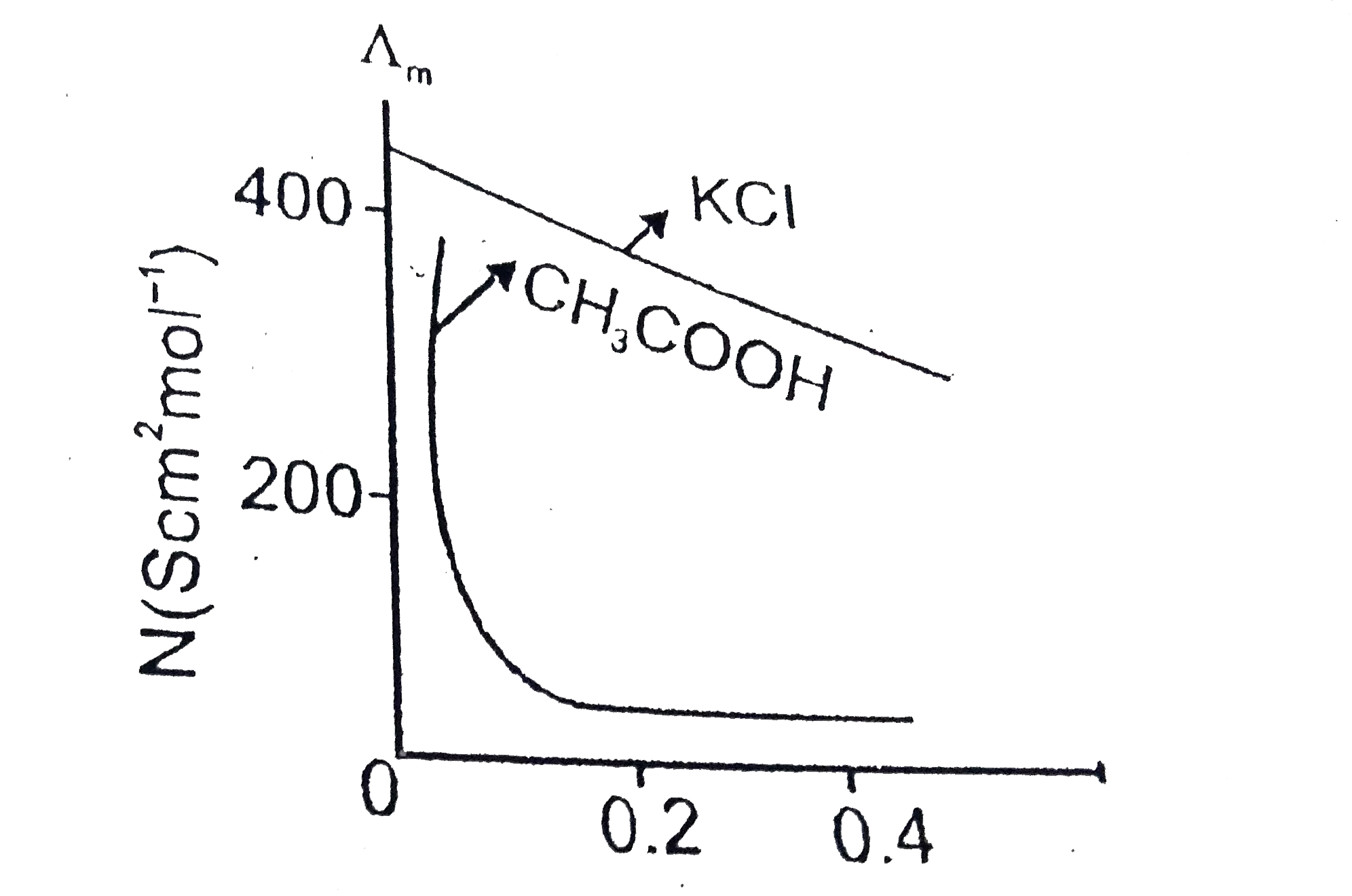(a) Define molar conductivity of a solution and explain how molar conductivity changes with change in concentration of solution for a weak and a strong electrolyte.
(b) The resistance of conductivity cell containing 0.001MKCl solution at 298K is 1500ohm. What is the cell constant if the conductivity of 0.001MKCl solution at 298K is 0.146×10−3Scm−1
(a). Molar conductivity= it is definied as the conducting power of all the ions produced by one gram mole of an electrolyte in solution it is denoted by ∧m
∧m=kC×1000Scm2mol−1
where k is is electrlytic conductivity of solution and C is concentration of the solution expressed in molL−1 (or mol dm−3)
Variation of conductivity and molar conductivity with concentration.
In case of strong electrolyte, ∧m increase a little on dilution as shown in figure by straight line (decrease in conc.) because number of ions do not increase appreciable, only mobility of ions increase whereas in case of weak electrolyte, number of ions as weill as mobility of ions increase appreciable, therefore ∧m increase sharply as shown in the figure in form of curve.
Molar conductivity versus C1/2 for acetic acid (weak electrolyte) and potassium chloride (strong electrolyte) in aqueous solutions,
(b). R=15000Ω,k=0.146×10−3Scm−1
k=−1R×lA⇒lA=k×R=0.146×10−3Scm−1×1500ohm
⇒lA=219×10−3cm−1=0.219cm−1 
Topper's Solved these Questions
- BOOK - RESONANCE ENGLISHCHAPTER - ELECTROCHEMISRYEXERCISE - Advanced Level Problems88videos
ELECTROCHEMISRY
- BOOK - RESONANCE ENGLISHCHAPTER - ELECTROCHEMISRYEXERCISE - Part 223videos
ELECTROCHEMISRY
- BOOK - RESONANCE ENGLISHCHAPTER - ELECTRO CHEMISTRYEXERCISE - PHYSICAL CHEMITRY (ELECTROCHEMISTRY)53videos
ELECTRO CHEMISTRY
- BOOK - RESONANCE ENGLISHCHAPTER - EQUIVALENT CONCEPT & TITRATIONSEXERCISE - Part -IV22videos
EQUIVALENT CONCEPT & TITRATIONS
Similar Questions
The resistance of conductivity cell containing 0.001 M KCl solution at 298 K is 1500 ohm. What is the cell constant if the conductivity of 0.001 M KCl solution at 298 K is 0.146×10−3Scm−1
View SolutionThe resistance of conductivity cell containing 0.001 M KCI solution at 298 K is 1500 ohm. What is the cell constant if the conductivity of 0.001 M KCI solution at 298 K is 0.146×10−3Scm−1
View Solution
Knowledge Check
- Question 1 - Select One
Molar conductivity of 0.15 M solution of KCI at 298 K, if its conductivity is 0.0152 S cm−1 will be
A124Ω−1cm2mol−1B204Ω−1cm2mol−1C101Ω−1cm2mol−1D300Ω−1cm2mol−1
The resistance of conductivity cell containing 0.001 M -KCI solution at 298 K is 1500 ohm what is the cell constant if the conductivity of 0.001 M KCI solution at 298 K is 0.145×10−3Scm−1 ?
View SolutionThe resistance of a conductivity cell contaning 0.001MKCl solution at 298K is 1500Ω. What is the cell constant if conductivity of 0.001MKCl solution at 298K is 0.146×10−3Scm−1.
View SolutionThe resistance of a conductivity cell containing 0.001M KCl solution at 298K is 1500Ω. What is the cell constant ( in mm−1) if the conductivity of 0.001M KCl solution is 2×10−3Smm−1
View SolutionThe resistance of a conductivity cell containing 0.001 M KCl solution at 298 K is 1500 ohm. What is the cell constant and molar conducti vity of 0.001 M KCI solution, if the conductivity of this solution is 0.146×10−3ohm−1cm−1 at 298 K?
View SolutionThe resistance of 0.01 M NaCl solution at 25°C is 200 ohm.The cell constant of the conductivity cell used is unity. Calculate the molar conductivity of the solution.
View SolutionThe conductivity of 0.10 M solution of KCl at 298 K is 0.025 S cm Calculate its molar conductivity.
View SolutionThe conductivity of 0.20 M solution of KCl at 298 K is 0.0248 S cm−1 . Calculate its molar conductivity.
View Solution

